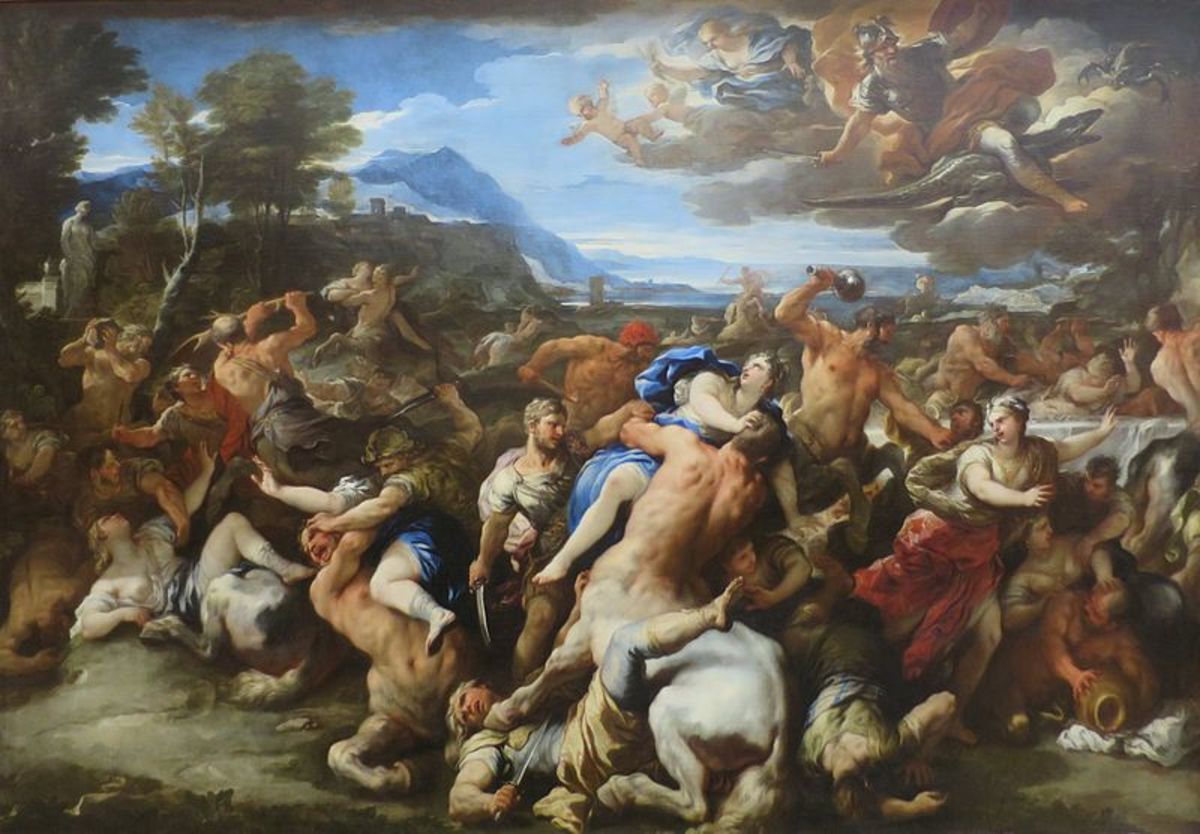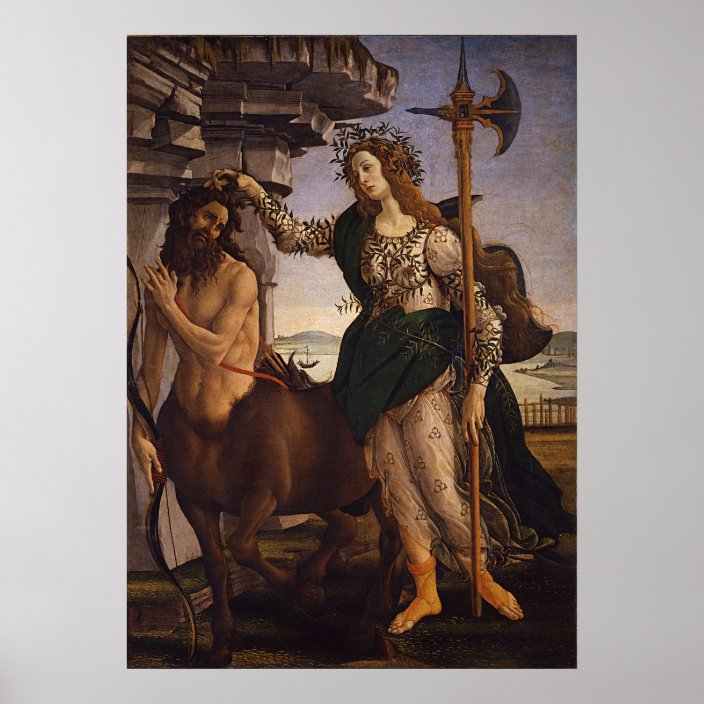
Centaurs in Greek Mythology hubpages
Botticelli "Pallas and the Centaur" at the Uffizi Gallery in Florence Tempera on Canvas (207 x 148 cm) 1482 Pallas and the Centaur This painting shows us a young woman, Minerva-Pallas, in front of a seascape, holding a centaur by her hair. Contrary to the usual image of a Pallas armed with a spear, she holds here a halberd, the Florentine.

Botticelli Pallas and the Centaur DaniellakruwPierce
The centaur, a mythical creature, combining man and beast, symbolises the feral instincts of humanity and therefore, the work is to be understood as an allegory to virtues that act as a brake on a bad-tempered, passionate temperament. A young woman wears a dress with repeat decoration of the three-ring insignia of the Medici family.

"Botticelli Pallas And The Centaur (Around 1482)" iPhone Case & Cover
Paintings, sculptures, and prints from Mia's collection will be shown alongside masterworks from the Uffizi, including rare paintings and drawings by Botticelli, such as his masterful Pallas and the Centaur (c. 1482); works by his teacher (Fra Filippo Lippi) and colleagues (Domenico Ghirlandaio, Cosimo Rosselli, Perugino); and ancient Greek and.

Detail from Pallas and the Centaur. Lithograph. After Sandro Etsy
Linda Proud. Pallas & the Centaur. Botticelli's painting represents the moment when Lorenzo approached Naples by boat to surrender to the enemy. The centaur symbolizes not Lorenzo but the bestial forces of greed and power which were attacking him. In this painting, Lorenzo is Pallas Athene. We are by nature dual.

Sandro Botticelli, Pallas and the Centaur. Tempera on canvas. 81 1/2 x
Pallas and the Centaur is the title of a painting created by Italian artist Sandro Botticelli. Botticelli, who lived from 1445 to 1510, was an important artist in the Italian Renaissance, a.

Pallas and the Centaur by Botticelli Poster
One of Botticelli's most successful works is Pallas and the Centaur, created around 1482 using tempera on canvas. To the left of the image is a centaur. To the right is a female figure, clutching the centaur's hair. The identity of this female figure is unclear.

Pallas and the Centaur Sandro Botticelli Aesthetic Inspiration Rain
Pallas and the Centaur was depicted by Sandro Botticelli in 1482 and now hangs in the Uffizi in Florence, Italy. The majority of Botticelli paintings are oil on panel, but this breaks from the mould in that it was on a large canvas - sized at 205cm x 148cm.. Today's artists predominantly use oil on canvas, but at that time Tempera was the tool of choice.

Pallas and the Centaur by Linda Proud
Pallas and the Centaur c. 1482 Tempera on canvas, 207 x 148 cm Galleria degli Uffizi, Florence: According to the inventory of 1499 which lists the property of Lorenzo di Pierfrancesco de' Medici, cousin of Lorenzo the Magnificent,the painting Pallas and the Centaur hung above a door in the same room as the Primavera. Its bare landscape focuses.

Pin by Zizo Lion on Random Collection Centaur, Mythological creatures
Pallas and the Centaur is a painting by the Italian Renaissance painter Sandro Botticelli, c. 1482. It is now in the Uffizi Gallery in Florence. It has been proposed as a companion piece to his Primavera, though it is a different shape. The medium used is tempera paints on canvas and its size is 207 x 148 cm.

Joshua Peeters' Parade Pallas en de centaur
Pallas and the Centaur is a painting by the Italian Renaissance painter Sandro Botticelli, c. 1482. It is now in the Uffizi Gallery in Florence. It has been proposed as a companion piece to his Primavera, though it is a different shape. [1] The medium used is tempera paints on canvas and its size is 207 x 148 cm.

Pallas with Centaur » Norton Simon Museum
Botticelli Pallas and the Centaur actually represents Lorenzo as Pallas/peace, holding the instinct of the Centaur/war. The cloth of the Goddess is decorated with a motif that was the personal symbol of Lorenzo (rings with diamond) and enriched by olive tree branches (the olive tree is a symbol of peace).

Pallas and the Centaur Painting in the Uffizi Gallery in Florence on
Pallas and the Centaur Linda Proud 4.53 49 ratings8 reviews Following the murders committed by the Pazzi Conspiracy, Lorenzo de' Medici sends his family out to the country under the care of Angelo Poliziano.

Pin on Athena
Pallas and the Centaur is a painting by the Italian Renaissance painter Sandro Botticelli, c. 1482. It is now in the Uffizi Gallery in Florence. It has been proposed as a companion piece to his Primavera, though it is a different shape. The medium used is tempera paints on canvas and its size is 207 x 148 cm.

"PALLAS AND THE CENTAUR" Poster for Sale by MatteoPergola Redbubble
"Pallas and the Centaur" by Sandro Botticelli depicts a centaur with a bow and arrows and a female figure holding a very elaborate halberd. She is clutching the centaur's hair, and he is submissive to her. The female character was called Camilla in the earliest record of the painting, but later she is called Minerva.

Antik Yunan’ın Fantastik Canavarları Düşünbil Portal
Pallas and the Centaur belongs to the same time period as Botticelli's famed Primavera and Birth of Venus, commissioned by the Medici in the 1480s. The painting draws inspiration from Antiquity, but there are still discussions about the true identity of the mysterious female figure.
Posterazzi Pallas And The Centaur (Minerva And The Centaur) Stretched
Pallas and the Centaur painting by Botticelli Learn about this topic in these articles: discussed in biography In Sandro Botticelli: Mythological paintings 1477-82), Pallas and the Centaur (c. 1485), Venus and Mars (c. 1485), and The Birth of Venus (c. 1485).